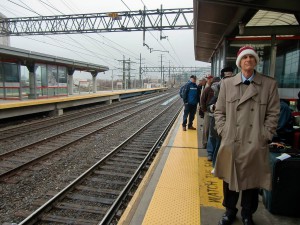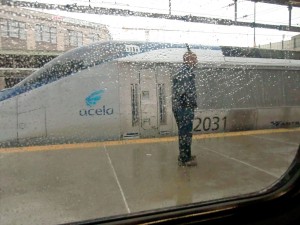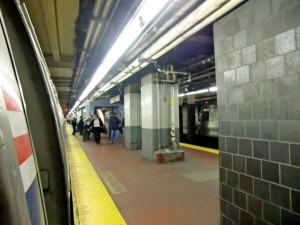IN SEARCH OF SNOW – DOWN THE EAST COAST
IN SEARCH OF SNOW
This is the 12th in a series of articles about traveling by rail in search of snow
DOWN THE EAST COAST
By Charles N. Stevens
Photos by Dolores Seidman
We wake up to a gray day in Stamford, Connecticut with a forecast of heavy rain, especially as we travel south today. But we are bolstered with a delightful breakfast at the Hampton Inn—cereal, eggs scrambled with ham, French toast and orange juice.
We are again stuffed in a school bus for the short trip to the railroad station. The windows are all fogged over and our hand luggage is piled on our laps, adding to the claustrophobic atmosphere in the overburdened bus.
Glad to be out of the “yellow coffin” and breathing fresh air in the open, we enter the confusion of the station, hundreds of people going every which way. A station agent finally leads us to a cold, windy platform to wait for our train. When it does arrive, the electric locomotive whirring into the station, we find that we are standing in the wrong place. Our car that we thought would be on the front of the train is actually the last car. We hurry down the length of the train, dodging people, hauling all our heavy luggage with us.
A fine drizzle begins as we board the train then rain begins in earnest as we head south down the rails. I am surprised at how many houses are built close to the rails, but we also streak by gray inlets and bare trees, all muted in the mistiness of the day. I’m pleased by the smoothness of our train, #95, as it speeds over a well maintained road bed. Some of our other train rides had been rather rocky at times.
We pass through more urban squalor with graffiti on every possible surface, adding to the blight and disorder. Our train rolls past industrial buildings, oil storage tanks and power plants as well as piles of dirt ad broken concrete. We finally get a quick view of Long Island Sound. The snow is long gone and is now only a memory.
Close to noon we arrive on the outskirts of New York City, the skyline in the distance before us, the tops of the highest skyscrapers lost in low clouds. We zip by acres of silver commuter trains then down into the tunnel that will lead us to Penn Station in the heart of the city. The maze of tracks and waiting trains is dimly lit in the bowels of the station; illuminated just enough for safety. We wait for 20 minutes in the station, other trains arriving and departing, the leaving ones with bright red lights on the rear car. I can’t help but think about the hustle and bustle of New York going on above us.
On our way again, we see nothing but darkness out of our window as the train gathers speed through a long tunnel that bores under the river. The train emerges in New Jersey among railroad yards, power plants and open spaces of straw-colored grasses. For a brief moment there is a faraway view of the Statue of Liberty. In a short time we arrive at the airy, white brick and metal station in busy Newark, New Jersey.
In minutes we’re zipping down the rails again through the murky day. As the weather man predicted, the rain has increased, the landscape out of the train windows soggier and more muted. Sometimes we pass bare forests and fields of tawny grasses, but the scudding clouds skim mainly over industry. Near Trenton the rails run close to a freeway, the speeding cars and trucks churning up clouds of mist. Bright lights and billows of steam rise from a refinery.
Ahead is the hazy skyline of Philadelphia, its highest buildings, like those of New York, poking up into the clouds. Philly’s railroad station is also underground and feebly lighted, but it protects the travelers from the elements. Leaving the station, we pass many row houses as well as junk and decrepit old buildings that really need to be torn down and cleaned up.
Before we arrive at Wilmington, Delaware we’re able to see Chesapeake Bay, looking very gray under the dull sky. The station at Wilmington is open and rainy, the platforms wet and strewn with puddles. So is the station at Baltimore, Maryland when we arrive about two-thirty in the afternoon. Again the train had sped by some rather squalid row houses, some of them looking abandoned. We notice as we travel south that the lawns are getting a little greener, not lush, but not the dead brown we saw farther north. The accumulating rain has caused some of the streams to overflow, flooding some of the fields. We skirt around the end of Thurgood Marshall Airport, its lights especially bright in the rainy day.
At last we reach our first destination of the day, Washington D.C. We are here only to change trains without a visit to any of the great treasures of the city. With a bit of walking in the drippy station we board the Capitol Limited that will take us to Chicago, an all-night trip.
As the day ends, we flash through Silver Springs and Rockville, Maryland then on to Harpers Ferry, West Virginia, a town of railroad bridges and the site of the death of the abolitionist John Brown in 1859 when he attempted to take over the U.S. Arsenal. At Martinsburg we actually see a complete brick railroad roundhouse, one of the few left in the country. At dinnertime we walk through the train to the diner, Dolores selecting braised beef while I try their tilapia. Both are very tasty.
Back in our compartment, we relax. It’s dark outside, and all we can see is our own reflections in the window glass, I just sitting there, Dolores reading a book. A light passes by, then the train stops at Cumberland where several passengers dash with umbrellas to board. The train starts up again, we see the lights of the town, neon signs for Caesar’s Pizza, KFC and Chic Filet, a few streetlights, then all is dark again. We had been traveling by train the whole day, and we are weary looking out the windows. The porter will soon make up our beds.

We wait on a wet, windy platform at Stamford, Connecticut for our train to Washington, D.C.

Through a rain-spattered window we see a sleek Acela train, Amtrak's fastest.

We finally arrive in Washington, D.C., but only to change trains.
MONTEREY PARK AUTHOR PUBLISHES 3RD BOOK ABOUT HIS EXPERIENCES IN WORLD WAR II- BACK FROM COMBAT
Charles “Norm” Stevens, a 40 year resident of Monterey Park and World War II Veteran has recently published the 3rd in his series about his experiences in WW II, Back from Combat: A WWII Bombardier Faces His Military Future. This book details the time from when he returned from combat in England where he flew 34 missions over Germany and France until the end of the war. Faced with large numbers of returning combat vets, and not knowing how long the war would continue, the military had to plan for their future. His options were whether to return to combat, become an instructor in the U.S., or receive new training that he would use in the Pacific. The book concludes with the end of the war with an Afterward that includes an update on the B-l7’s still flying in the U.S., as well as present day accounts pertaining to the war.
Stevens is the author of two previous books about his experiences:
An Innocent at Polebrook: A Memoir of an 8th Air Force Bombardier (Story of his 34 bombing missions from his base at Polebrook, England over Germany and France)
The Innocent Cadet: Becoming A World War II Bombardier (A prequel to the first, telling of his training in the U.S. before going overseas into combat.)
He is known to the readers of The Citizen’s Voice as the author of Travel Log Articles including “From Paris to Normandy on the Seine”, “Exploring New York” and “In Search of Snow.” He is retired, having taught for 32 years, primarily in the Montebello Unified School District.
Those interested in purchasing an autographed copy of any of his books, may contact the author at 323-721-8230 or Normstevens24@gmail.com.



